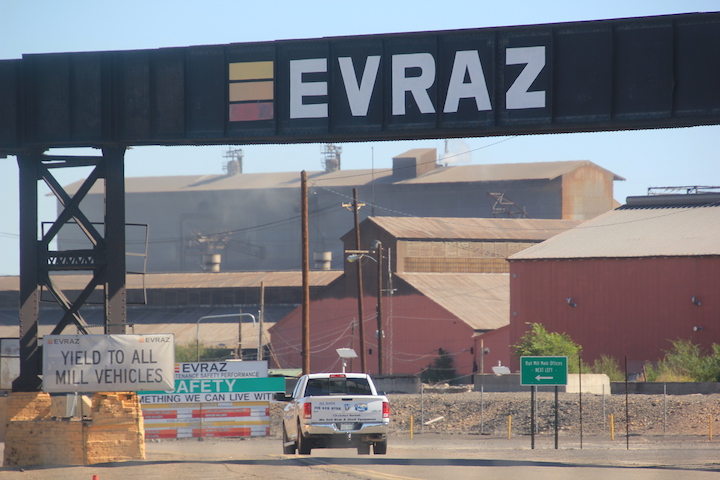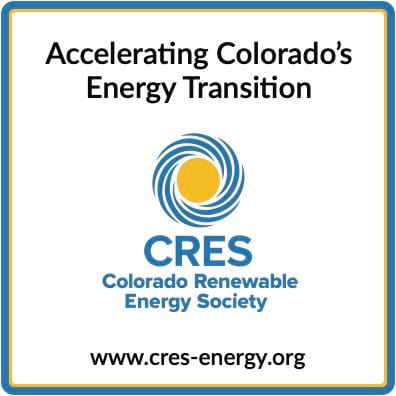Existing Pawnee coal plant would be reconfigured to burn hydrogen to create electricity. New research, however, warns that hydrogen could be a step backward.
by Allen Best
Colorado’s greatest hope in securing federal aid to lay the foundations for a hydrogen economy lies at Brush, 90 miles northeast of Denver.
There, Xcel Energy proposes to modify the Pawnee power plant to use hydrogen to fuel the existing steam boiler. The hydrogen is to be created from wind and solar generation, augmenting the natural gas that within a few years will replace coal now burned to produce the steam that then generates electricity.
That detail can be found in an otherwise heavily redacted concept paper submitted to the U.S. Department of Energy in November 2022 in a bid to secure $1.25 billion in federal funding for research and development of hydrogen in Colorado and three adjoining states. The project is called the Western Interstate Hydrogen Hub LLC.
Both Xcel and Colorado state government issued press releases this week announcing that the states—New Mexico, Wyoming, and Utah, in addition to Colorado—had submitted their application.
Some environmental advocates remain wary. They point to research from Princeton University and the National Oceanic and Atmospheric Association that suggests hydrogen’s potential as a clean fuel could be limited by a chemical reaction in the lower atmosphere.
The research found that above a certain threshold, even when replacing fossil fuels, a leaky hydrogen economy could cause near-term environmental harm by increasing the amount of methane in the atmosphere.
“We have a lot to learn about the consequences of using hydrogen, so that the switch to hydrogen, a seemingly clean fuel, doesn’t create new environmental challenges,” said Amilcare Porporato, a professor of civil and environmental engineering at Princeton.
The federal funding for hydrogen hubs was announced by the Department of Energy last September. Altogether, $7 billion will be available for 6 to 10 hydrogen “hubs” across the United States. The money comes from an allocation of $8 billion in the Bipartisan Infrastructure Law that was passed by Congress in 2021.
U.S. Secretary of Energy Jennifer M. Granholm in September described the hubs as a “once-in-a-generation opportunity to lay the foundation for the clean hydrogen future President Biden is building—one that will lift our economy, protect the planet, and improve our health.”
Will Toor, the director of the Colorado Energy Office, was only slightly more circumspect in his language when I talked with him this week. He said he has a measure of confidence Colorado and neighbors will get chosen. In that case, an electrolyzer will be installed in the middle of this decade and production will be ramped up over time.
An electrolyzer uses electricity to split water into hydrogen and oxygen. Colorado’s proposal emphasizes use of renewables as the source of electricity.
Can hydrogen scale as a technology? That depends, at least in part, upon whether the cost curve can be bent down.
“I think the combination of technology improvements and the economic course created by the production tax credits for hydrogen in the Inflation Reduction Act of 2022 has given a significant boost to making it possible to deploy hydrogen at a meaningful scale,” said Toor.

Will Toor at a bill-signing ceremony at the Denver Botanic Gardens in 2021.
Hydrogen is not the only way forward with the energy transition, he said, but rather one of several potential paths to move forward into a deeply decarbonized economy.
The Colorado Energy Office sees hydrogen as being among a suite of emerging technologies along with advanced geothermal and carbon capture that could potentially become deployed at meaningful scale, he said. But all have uncertainties, including cost trajectories that will influence how effective these technologies will be.
“We see them as important tools in the tool box to achieve deep decarbonization. What we are doing is creating an environment to enable early deployment from which we will learn about the cost trajectories and scaling potential over time. I think it’s premature to pick technological winners and losers. There is a suite of technologies that we need to start moving forward on, over time. I think we will see which ones are able to scale,” Toor said.
What if the proposal by Colorado and its neighbors gets rejected?
Toor says he sees this outcome, if unlikely, as still a useful exercise because it caused Colorado and its neighbors to work together and interact with the private sector on potential hydrogen projects.
“It is up to us to clarify the hydrogen opportunities in the region. And I think we are very optimistic about being chosen for regional hydrogen hub funding, which would be a major boost,” he said. “But I think we will see momentum on clean hydrogen regardless of the outcome.”
The eight specific proposals submitted in the package vary substantially in their configurations. In New Mexico, for example, the Navajo Agricultural Production Industries plans to convert its farming operation to operate on hydrogen fuel, including all major farm equipment. In Utah, Dominion Energy proposes to begin high-pressure blending of hydrogen with methane, with the intent of producing synthetic natural gas, by 2027.
Tallgrass Energy is the majority owner of a former Tri-State Generation and Transmission coal plant at Escalante, west of Albuquerque, and there it plans to produce hydrogen from natural gas, what is called “blue” hydrogen, and capture and sequester the emissions. It is developing a sequestration hub in eastern Wyoming in partnership with the State of Wyoming.
Several proposals envision electrical generation, but some also see potential to supply hydrogen to long-haul truckers.
Early in this development, Xcel would blend the hydrogen with natural gas in its existing pipelines, with the upper threshold at 10% by volume.
The proposal calls for transporting hydrogen among the four states—and beyond—using existing natural gas pipelines along established corridors through blending with the methane as well as through new, dedicated hydrogen pipelines along both existing and new corridors. Other transport mechanisms, such as a compressed gas, may also be possible.
Key connections are to include a link between Escalante in New Mexico to Brush in Colorado to Cheyenne and then to Salt Lake City. The concept paper calls this distribution and use web a “hydrogen ecosystem.”
Please is from Big Pivots 72. Please consider supporting Big Pivots in whatever way you feel appropriate.
The Front Range of Colorado will be key as 40% of the residents in the Mountain West live between metropolitan Colorado Springs and Fort Collins. Metro Denver alone has about 25% of the total population.
The location of Pawnee—in the windy Great Plains but close to that large market in the Front Range—seems to be crucial.
Bob Frenzel, the chief executive of Minneapolis-based Xcel, nodded at the location in his statement that the company’s project in Colorado “offers a strategic advantage with its proximity to customer end uses, generation and gas and electric distribution infrastructure, and some of the best wind and solar resources in the country for producing clean hydrogen.”
“Salt caverns, already developed in eastern Colorado for natural gas storage, are being evaluated for hydrogen storage,” the concept paper says.
Xcel only described the location as “eastern Colorado.”
At Brush, Xcel also has a 300-megawatt natural gas plant, Manchief, which was designed to meet peak demands for electricity. It plans to convert Pawnee from coal to natural gas combustion by 2026.
Colorado and other states see hydrogen as a possible way to curb emissions from otherwise hard-to-decarbonize economics sectors, including industry. For example can clean hydrogen be deployed at the Rocky Mountain Steel mill in Pueblo or in distribution centers to fuel forklifts? Or at the Kennecott copper mine near Salt Lake City with its 300-ton haul trucks?
Accompanying Colorado’s participation in this regional approach to hydrogen development is a proposed law, HB23-1281, “Advance the Use of Clean Hydrogen.” That bill will get its first hearing on Thursday, April 20, before the Colorado House Energy and Environment Committee.
Toor says the legislation would do two things: create a tax credit for the use of clean hydrogen in hard-to-decarbonize sectors, including heavy transportation. It would also give the Public Utilities Commission criteria for considering any utility application for clean hydrogen investment.
“It is not absolutely essential, but it would be very useful legislation to accompany the regional hydrogen hub application,” he says. “The PUC could certainly consider an application but it gives clear criteria when considering such an application.”
That legislation would also require an assessment of the annual volume of water used in electrolysis of water to produce clean hydrogen.
Toor says relatively little water would be required for the hydrogen projects at the scale contemplated by the application for federal funding.
The federal program requires production of a minimum of 100 tons a day of hydrogen, although the production of the eight projects likely would exceed that, says Toor. The minimum, however, would require only 265 acre-feet of water annually.
“It is easy to do these calculations,” added Toor, who has a doctorate in physics. “Making one kilogram of hydrogen requires nine kilograms of water.”
The 265 acre-feet is what a 60-acre alfalfa farm in Colorado would need annually. One golf course in Boulder County uses 1,947 acre-feet annually. However, the average annual water use per golf course in Colorado is 225 acre-feet.
“At least as being contemplated right now, it’s pretty modest,” he said. Retirement of coal plants will leave more than 100,000 acre-feet available in Colorado, he pointed out, citing a March 2020 Colorado Sun story.
“So certainly it’s an issue to keep our eyes on, but at least at the scale being contemplated today, it’s probably not a major issue.”

The steel mill in Pueblo is mentioned as one of the industries that could benefit from development of hydrogen. Photo/Allen Best
The potential for unintended consequences in the troposphere may be a more troublesome element for hydrogen proponents. The Princeton and NOAA researchers say the problem boils down to one small, difficult-to-measure molecule known as the hydroxyl radical, or OH. It’s often been called “the detergent of the troposphere” because it plays a critical role in eliminating greenhouse gases such as methane and ozone from the atmosphere.
This radical molecule also reacts with hydrogen gas. Because there is a limited amount of OH generated each day, any spike in hydrogen emissions means that more OH would be used to break down hydrogen, leaving less OH available to break down methane. As a consequence, methane would stay longer in the atmosphere, extending the warming impacts.
“If you emit some hydrogen into the atmosphere now, it will lead to a progressive buildup of methane in the following years,” said Princeton’s Matteo Bertagni, the first author of the research article published in Nature Communication. He’s a postdoctoral researcher working on the Carbon Mitigation Initiative.
For “green” hydrogen, i.e. that which is produced using electrolysis using renewable energy, Bertagni said the critical threshold for hydrogen emissions sits at around 9%. That means that if more than 9% of the green hydrogen produced leaks into the atmosphere —whether that be at the point of production, sometime during transport, or anywhere else along the value chain—atmospheric methane would increase over the next few decades, canceling out some of the climate benefits of switching away from fossil fuels.
And for blue hydrogen, which refers to hydrogen produced via methane reforming with subsequent carbon capture and storage, the threshold for emissions is even lower. Because methane itself is the primary input for the process of methane reforming, blue hydrogen producers have to consider direct methane leakage in addition to hydrogen leakage. For example, the researchers found that even with a methane leakage rate as low as 0.5%, hydrogen leakages would have to be kept under around 4.5% to avoid increasing atmospheric methane concentrations.
“Managing leakage rates of hydrogen and methane will be critical,” Bertagni said. “If you have just a small amount of methane leakage and a bit of hydrogen leakage, then the blue hydrogen that you produce really might not be much better than using fossil fuels, at least for the next 20 to 30 years.”
- Kick the (coal) can down the road to 2040? - January 13, 2026
- Pluses and minuses for Colorado’s eastern plains - January 11, 2026
- Rural vs. urban in a panel at History Colorado - January 10, 2026







Good article, Allen ! I appreciate the details about the many sides and challenges of hydrogen creation.
Your section regarding hydrogen transport reminds me of a conversation I had several years ago with a chemist at the U.S. Department of Energy’s Golden Field Office. He mentioned the corrosive nature of hydrogen that, if sent through a standard petroleum pipeline, would render the pipeline useless within months of operation. That is why the Golden Field Office and National Renewable Energy Lab have spent billions of dollars on research and development of (cost-effective) coatings for pipelines and storage tanks. Titanium works well, but titanium comes with a high price tag, making it cost-prohibitive, especially for long distance pipelines.
https://www1.eere.energy.gov/hydrogenandfuelcells/pdfs/hpwgw_matsolutions_das.pdf
I think H2 is nifty. To get from 20ish% fossil fuel backup of variable renewables to 0% fossil burning H2 in generators is a potential use. But we are decades from that condition statewide. Any “blending” of H2 into the gas supply is a total waste. The best portrayal I’ve seen of this is: https://cleantechnica.com/2023/02/13/why-arent-energy-flows-diagrams-used-more-to-inform-decarbonization/
If Xcel and others think there is or will be extra or otherwise-curtailed renewable generation, they need to provide that to customers at low cost for use in heating electrification and thermal storage, not hoard it for their scheme-de-jour.
In the past year, I’ve heard of multiple schemes from Xcel for liquid sodium thermal storage for generation at Hayden, a big pumped hydro scheme (which is at least efficient), the Form Energy long duration iron battery, and now this. I’m more impressed with Holy Cross and their emphasis on over-building wind, and then truly pushing local storage and demand management and rates which truly encourage heating electrification.
Hydrogen storage and use on a mass scale has many issues, the largest being the very poor round-trip thermodynamic efficiency with electrolysis of water – better to store excess electrical energy in batteries, thermowells (liquid sodium, etc.) or pumped hydro, and only use H2 for direct process needs. As a chemical engineer who has direct experience in H2 generation, usage and plant design (H2O2 manufacturing) there are a lot of issues that politicians are glossing over (or most likely don’t have a clue about since most are lawyers). For now, I consider this a boondoggle and a waste of taxpayer funds beyond basic science and engineering research.
Affecting the upper atmosphere is just one more nail in the coffin for widespread H2 usage.